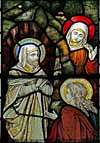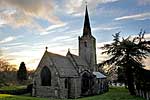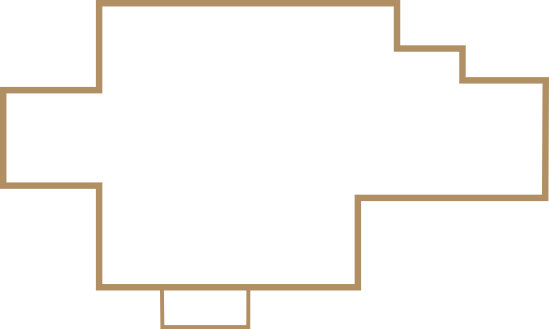For this church:    |
|
Key to Glass |
Chancel
 |
 |
 |
 |
 |
| To the Glory of our Risen Lord and in loving memory of Ralph Owen Yearsley M.A. Rector of this parish 1866-1913, who died 29th April 1917 this window is dedicated by his widow and sons. |
 |
 |
 |
 |
 |
The east window is another magnificent window by Kempe with the two logos, the wheatsheaf shield and ATE as in Window 16. This shows St Michael at the top killing a red dragon with cherubs either side. Below are six angels. The centre panel shows Jesus on the cross with INRI above and Jerusalem in the background. INRI stands for ‘Iesus Nazarenus Rex Iudaeorum’, ‘Jesus of Nazareth King of the Jews’. Either side of the cross are Mary to the left and John to the right. On either side of them are two bishops, the right hand one shows Lichfield Cathedral in the background. Below are the symbols of the four gospel writers with their names in Latin. Matthew and Mark to the left and Luke and John to the right. In the centre is a Pelican feeding her young, symbolic of Jesus’ sacrifice on the cross. The inscription reads:
To the glory of God and in |
 |
 |
 |
 |
The westernmost window in the south chancel, depicts Jesus appearing to Mary Magdalene at the resurrection. At the top are the letters ‘Ihs’ surrounded by the words ‘Touch me not’. Lilies are represented on both sides. To the left is the risen Lord Jesus with ointment and cloth on the floor and to the right is Mary Magdalene with long auburn hair and the empty tomb in the background. Mary has been given the face of the Rev R O Yearsley’s wife, Maria, who died in Bermuda 17 July 1882 aged 37. The inscription reads:
| TO THE GLORY OF GOD AND IN MEMORY OF MARIA GRACE BRODIE, THE BELOVED WIFE OF RALPH OWEN YEARSLEY MA RECTOR OF THIS PARISH OBIIT BERMUDA XVII DIE JULII ANN DOM 1882 ET AETATIS SUAE 37. |
South Aisle
 |
 |
The window at the east end of the south aisle shows the story of the Good Samaritan. This is the oldest of the windows and has some odd features. The story appears to read from right to left, and, between scene one and two, the donkey has changed his bridle and the Good Samaritan has changed his cloak! There are decorated panels above the story. On the left hand side the Good Samaritan is shown negotiating with the innkeeper to take care of the injured man. In the centre the Samaritan helps the man onto his donkey and in the right hand side the Samaritan is seen treating the injured man’s wounds, with the priest and the Levite in the background, walking guiltily away.
The window commemorates Jonathan Burton who died 30 May 1858. The inscription along the bottom of the window reads:
| IN MEM: OF JONATHAN BURTON GENT: OF THIS PARISH WHO DIED MAY XXX MDCCCLVIII THIS WINDOW WAS BUILT AND FILLED WITH STAINED GLASS BY HIS AFFECTIONATE WIDOW |
 |
 |
 |
 |
The window shows Lazarus being raised from the dead. At the top is an angel with the words ‘Halleluiah, Halleluiah’. There are decorative panels above the figures. To the left is Lazarus coming out of the tomb in his grave clothes with Mary and Martha looking on and to the right is Jesus with his disciple John. Below it reads ‘He that was dead came forth’ with decorative squares underneath. The inscription below the window reads:
| Ad Gloriam Dei et in memoriam Thomae Knowles Tillotson obiit Ann: Dom: 1878 hanc fenestram posuit maerens uxor. |
Translated the inscription reads 'To the glory of God and in memory of Thomas Knowles Tillotson who died in the year of our Lord 1878 this window was placed by his grieving wife.'
 |
 |
 |
 |
 |
The window in the west wall of the south aisle has the dedication:
| IN LOVING MEMORY OF ROBERT ADOLPHUS CECIL TILNEY 26TH APRIL 1959 |
This window shows four shields or crests. On the right hand side is Robert Tilney’s regiment 'Death or Glory' The Lancers, (now the Royal Lancers). Skull and crossbones with the motto ‘or glory’. In the centre, at the top is the Southwell Diocese Crest and below it the Tilney Family Coat of Arms, motto 'Sperando Spiro' (I live by hoping). The crest on the left hand side is unidentified. In the left hand corner is the maker’s mark for Goddard and Gibbs: a sailing ship with the initials GG on the sail. At the top of the window are two Tudor roses and the date AD 1963.
Tower
11. The window in the west wall of the tower is best seen from the chancel steps. It shows a beautiful garden with trees, stream and beautiful flowers, daffodils, delphiniums, clematis, lilies, marigolds, phlox, primroses and snowdrops in the foreground. There are fields in the background with a cottage and church in the distance. The windswept blue sky is lovely. A banner at the top of the window reads ‘Te Deum Laudamus’, (we praise thee God). The inscription reads:
The window in the west wall of the tower is best seen from the chancel steps. It shows a beautiful garden with trees, stream and beautiful flowers, daffodils, delphiniums, clematis, lilies, marigolds, phlox, primroses and snowdrops in the foreground. There are fields in the background with a cottage and church in the distance. The windswept blue sky is lovely. A banner at the top of the window reads ‘Te Deum Laudamus’, (we praise thee God). The inscription reads:
| THIS WINDOW WAS GIVEN BY CECIL WALTER PAGET |
The artist was Reginald Bell of Clayton & Bell.
There is no date but the style is 1920s/30s.
North Aisle
 |
 |
 |
 |
TO THE GLORY OF GOD AND IN MEMORY OF HIS FATHER GEORGE ERNEST PAGET |
The artist was Reginald Bell of Clayton & Bell.
 |
 |
 |
 |
The window is an unusual depiction of a hunting scene. It shows a huntsman with a horn and knife gazing at a deer with a crucifix between its antlers. This represents either St Hubert or St Eustace, both are patron saints of hunting and both repented of their wasted lives after seeing a vision of a stag and crucifix. There is a crest at the top of the window and the scene is made local with Sutton Bonington Hall in the background on the left and St Michael’s Church on the right. A fox hound stands among the bracken and foliage and a fox is racing away in the right hand corner. The window was made by Goddard and Gibbs. The inscription reads:
| DEDICATED IN GRATEFUL MEMORY OF WILLIAM ARTHUR AND HYLDA SOPHIA PAGET TILNEY BY THEIR SON RAGT 1961. |
 |
 |
 |
 |
The window shows St Michael and St George each battling their respective dragons. At the top are a crown and a horn, the crest of the Rifle Brigade. St Michael stands on the left, resplendent in armour and wings with a bejewelled cloak, killing a blue/grey dragon. On the right stands St George in equally magnificent armour. He is killing a red dragon with a spear, appropriately flying a St George’s flag. A wheatsheaf in the left hand corner shows the window was executed by C. E. Kempe. The inscription reads:
| To the glory of God and in loving memory of George Leigh Paget, Captain Rifle Brigade who after wounds received in action October 9th died at Vlakfontein, Transvaal, South Africa October 10th 1900 aged 29. |
 |
 |
 |
 |
There is an angel at the top holding a banner ‘Charity’ and at the bottom left there is an angel with a banner ‘Faith’ and an angel holding ‘Hope’ at the bottom right. In between stand two angels, gorgeously robed with the one on the right holding a bible. There is no maker’s mark visible but the Rev W E Buckland records it as being produced by Clayton and Bell. The faces of the angels are quite beautiful. The inscription reads:
| To the Glory of God and in loving memory of his wife Sophia this window is erected by Ernest Paget. |
Sophia died in 1913.
 |
 |
 |
 |
 |
At the east end of the north aisle is the eighth window depicting the Nativity. There are six angels at the top of the window, three of whom carry Latin inscriptions. On either side of the angels are the Kempe logos, three wheatsheaves in a shield to the left and ATE in a shield to the right (Alfred Tombleson). Below are a host of angels and underneath are two angels to the right, then two shepherds. Mary and the baby Jesus are next with Joseph and a third shepherd on the right. Below are four well dressed gentlemen carrying scrolls with Latin inscriptions which are hard to decipher but are approximately as follows: 'Ecce virgo concipiet' 'Ax nihi egredietur' 'Suscitabo David germen ----' 'Ecce tuus veniet rex' Could these be Magi? The inscription reads:
| To the glory of God, and in loving memory of George Byng Paget; Sophia Mary his wife, and Eliza and George Ernest his children dedicate this window A.D. 1896. |
The Crucifixion and the Nativity windows (windows 3 and 16) were dedicated on Easter Sunday 1897. The report in the Leicester Chronicle dated 24 April 1897 reads:
'St MICHAEL’S CHURCH. – On Easter Sunday two beautiful stained glass east windows were unveiled and dedicated, the one in the north aisle – anciently the Lady Chapel – erected to the memory of the late Mr George Byng Paget by his widow and children; the other in the chancel, to his widow (lately deceased), by her only son, Mr George Ernest Paget, of Sutton Hall. The work has been executed by Mr C. E. Kemp.'







